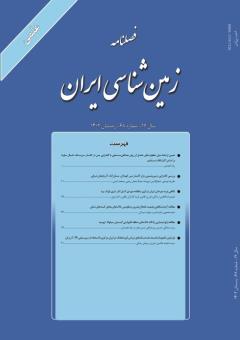مطالعه آزمایشگاهی وضعیت انحلال پذیری و مقاومتی خاکهای مجاور گنبدهای نمکی
محورهای موضوعی :میثم محبوبی نیازمندی 1 , سهراب میراثی 2 *
1 - مدرس دانشگاه، دانشکده مهندسی عمران، مؤسسه آموزش عالی مهرآیین، گیلان، ایران
2 - استادیار، دانشکده مهندسي عمران، واحد شهرکرد، دانشگاه آزاد اسلامی، شهرکرد، ايران
کلید واژه: انحلال پذیری, خاکهای نمکی, گنبدهای نمکی, جزيره هرمز, مقاومت خاک.,
چکیده مقاله :
يكی از مهمترين منابع بالقوه شوری در جنوب ايران، انحلال گنبدهای نمكی می¬باشد كه در اغلب موارد موجب تخريب كيفيت آب¬های سطحی و آبخوان¬های كارستی و آبرفتی مجاور می¬گردد. با وجودی كه آب-های كارستی و آبرفتی عموماً دارای كيفيت مطلوبی می¬باشند، در موارد متعددی در جنوب كشور كيفيت اين آب¬ها به دليل تماس با گنبدهای نمكی كاهش يافته است. نظر به اینکه برخی از نقاط استان هرمزگان همچون جزيره هرمز متشکل از خاک¬های انحلال¬پذیر نمکی و دارای درصد زیادی سولفات و گچ مي باشد احتمال رخداد مشکلاتی چون انحلال پذیری زياد مي باشد. لذا، در اين مقاله به بررسی و ارزیابی تعیین میزان انحلال پذیری و مشخصات مقاومتي خاکهاي مناطق واقع در مجاورت گنبدهای نمکی جزيره هرمز پرداخته شده است. تعیین مشخصات مقاومتي و انحلال پذيري بر اساس نتايج آزمايشات فيزيكي، شيميايي، فني و مكانيكي با استفاده از حفر گمانه¬ها و نمونه¬برداری انجام پذيرفته است. برخي از اين خصوصيات شامل طبقه بندي خاك، حدود اتربرگ خاك، درصد نمك، كلرور و فسفات، درصد تراكم حداكثر، زاويه اصطكاك، چسبندگي خاك و مدول الاستيسيته خاك منطقه مي باشند. نتايج بدست آمده نشان دادند كه وجود نمک، باعث کاهش پارامترهاي مقاومتي (زاویه اصطکاک داخلی و چسبندگی) خاک گردیده است. همچنين وجود نمک، باعث افزایش درصد رطوبت بهینه و كاهش قابل ملاحضه ميزان دانسيته خشك حداكثر خاک¬های انحلال پذیر در مقایسه با نمونه خاک طبیعی مي گردد. در نهایت بر اساس داده هاي بدست آمده و شناسايي دقيق خاك هاي انحلال پذير و نظز به ساخت و سازهاي آتي در اين مناطق، راهکارهای پيشنهادي جهت جلوگيري و كنترل خسارت به سازه واقع بر روی اين نوع خاکها ارايه شده است.
One of the most important potential sources of salinity in southern Iran is the dissolution of salt domes, which in most cases leads to the deterioration of the quality of surface waters, karstic aquifers, and adjacent alluvial aquifers. Although karstic and alluvial waters generally have good quality, in many cases in the south of the country, the quality of these waters has decreased due to contact with salt domes. This issue is particularly important in areas such as the lands located on the coasts of the Persian Gulf, where the groundwater level is high. Given that some areas of Hormozgan province, such as Hormuz Island, are composed of salt-susceptible soils with a high percentage of sulfate and gypsum, the occurrence of problems such as subsidence, deviation, and high susceptibility to dissolution is likely. Therefore, this article focuses on examining and evaluating the determination of the susceptibility to dissolution and the resistance characteristics of soils in the areas adjacent to the salt domes on Hormuz Island. The determination of resistance characteristics and susceptibility to dissolution has been carried out based on the results of physical, chemical, technical, and mechanical tests using boreholes and sampling. Some of these characteristics include soil classification, soil moisture content, salt percentage, chloride and phosphate content, maximum density percentage, friction angle, soil cohesion, elasticity modulus, and soil compaction index. The results showed that the presence of salt has led to a decrease in resistance parameters (internal friction angle and cohesion) of the soil. This reduction in cohesion in salt-containing samples compared to natural soil samples without salt has been more pronounced. In addition, the presence of salt leads to an increase in optimal moisture content and a noticeable decrease in maximum dry density of the highly susceptible dissolution soils compared to natural soil samples. Finally, based on the obtained data and the precise identification of susceptible dissolution soils and consideration for future construction in these areas, proposed solutions for preventing and controlling damage to structures on this type of soil have been presented.
[ ] Mirassi, S. and Rahnema, H., 2020. Deep cavity detection using propagation of seismic waves in homogenous half-space and layered soil media. Asian J Civ Eng, 21, 1431–1441 (2020). https://doi.org/10.1007/s42107-020-00288-2
[ ] Rahnema, H. and Mirasi, S., 2012. Seismic and geotechnical study of land subsidence and vulnerability of rural buildings. International Journal of Geosciences, 3(04), p.878.
[ ] Rahnema, H. and Mirassi, S., 2014. Crisis management concerning underground water falling and land subsidence occurrence in the plains of Iran. Advances in Environmental Biology, pp.1453-1466.

